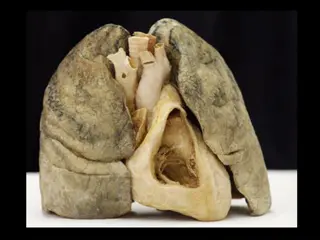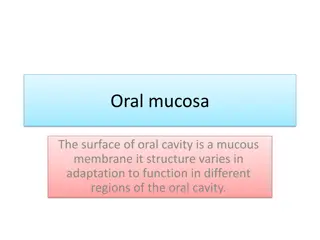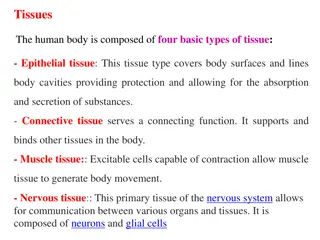Understanding Glandular Specialized Epithelium and Glands
Glandular specialized epithelium forms a class of epithelial tissues with specific functions and structures, composed of cuboidal, columnar, and ciliated columnar epithelial cells. These tissues contain gland cells that are secretary in nature, with zymogen granules in the cytoplasm. Glands are specialized cells, groups of cells, or organs of endothelial origin that remove, concentrate, alter materials from the blood, and secrete them for body use or elimination. Glands can be classified based on duct presence, secretory part, nature of secretion, and mode of secretion.
Download Presentation

Please find below an Image/Link to download the presentation.
The content on the website is provided AS IS for your information and personal use only. It may not be sold, licensed, or shared on other websites without obtaining consent from the author. Download presentation by click this link. If you encounter any issues during the download, it is possible that the publisher has removed the file from their server.
E N D
Presentation Transcript
Glandular Specialized Epithelium Glandular Specialized Epithelium
Glandular Specialized Epithelium Glandular Specialized Epithelium Specialized Epithelial Tissue are a class of epithelial tissues that have very specific and specialized functions and structures. This tissue is composed of cuboidal, columnar, ciliated columnar epithelial cells. Glandular Specialized Epithelium Glandular Specialized Epithelium Contain cells of the glands are secretary in nature. Zymogen granules appear in the cytoplasm of secretary cells. A gland can be classified on the basis of presence and absence of ducts, number of cells and shape of secretary unit.
What is a Gland? The gland is a specialized cell, group of cells, or organ of endothelial origin that selectively removes materials from the blood, concentrates or alters them, and secretes them for further use in the body or for elimination from the body. . Most glands are formed during development by proliferation of epithelial cells so that they project into the underlying connective tissue.
It is classified:1- According to the duct. 2- According to the secretory part. 3- According to nature of secretion. 4- According to mode of secretion.
Branching of the duct: A-Simple glands possess one unbranched duct e.g. intestinal, gastric glands. B-Compound glands have branched duct system e.g. salivary
II II- - According to the secretory part According to the secretory part. (A) Number of cells Number of cells : Unicellular glands: formed of a single cell e.g. goblet cells. Multicellular glands: formed of numerous cells e.g. salivary gland. (B)Shape of the secretory part: Shape of the secretory part: The glands in our bodies come in three overarching shapes. Acinar, meaning 'grape,' are ducts that have a large, bulbous collection of secretory and excretory cells within a small lumen, or interior space. They look something like a cluster of grapes in the body, hence their name. Tubular glands Tubular glands have cells of a consistent shape that form a uniform tubular lumen, while alveolar glands alveolar glands have cells of a similarly uniform size within a large, sac-like lumen. Tubular and alveolar glands can be further subdivided by their shape into simple, or non-branching glands, and compound, or branching glands. Acinar,
Simple Glands Simple Glands Thankfully, the terminology for these glands is fairly self-explanatory, which should make them relatively easy to remember. Simple glands are exactly what you would think of in relation to shape: they have a simple straight duct duct, or opening, that connects the secretory and excretory cells, and where the exterior of the tissue is straight, without any complex branching systems.
Tubular glands Tubular glands come in three simple shapes: simple tubular, simple coiled tubular, and simple branched tubular. Alveolar glands have two simple shapes: simple alveolar and simple branched alveolar. Let's take a quick look at what these glands look like and where they might be found in the body. Alveolar glands only
Simple tubular glands Simple tubular glands are one of more uncommon shapes that, in a cross section, simply look like a straight test tube submerged in the tissue. These glands are found in the lining of the intestines, where they secrete mucous to help the byproducts of digestion pass through the intestinal tract.
Simple coiled tubular glands Simple coiled tubular glands are like coiled tubes. They basically look like a garden hose tangled or coiled around itself at one end. The sweat glands in your skin are simple coiled tubular glands. Simple Simple branched tubular glands tubular glands have a straight duct opening with branched clusters of secretory glands They include the gastric glands glands of your stomach that produce acid, as well as the mucous secreting glands glands lining your esophagus, tongue, and duodenum of your small intestines glands.
Alveolar glands: have alveolar (flask shaped) or acinar (grape like) secretory parts Branched alveolar glands are classified as follows:
Tubulo-alveolar glands: If glands by shape, alveolar glands tubular glands glands. Alveolar glands secretory portion, thus are also termed saccular glands glands. They typically have an enlarged lumen (cavity), hence the name similar to alveoli, the very small air sacs in the lungs. glands are categorized glandscontrast with glands have a saclike
III III- - According to nature secretion According to nature secretion 1- Mucous glands Mucous glands: produce viscid mucous poor in enzymes e.g. goblet cells and minor salivary glands. 2- Serous glands: Serous glands: produce watery solution rich in enzymes e.g. Parotid glands and pancreas. 3- Mucoserous Mucoserous glands glands: produce both types of secretions e.g. submandibular and sublingual glands. Sweat glands Sweat glands ;of skin produce watery secretion containing some enzymes and waste products Oily glands: Oily glands: secrete fatty secretion e.g. sebaceous and tarsal glands Waxy glands: Waxy glands: secret waxy secretion e.g. ceruminous glands of the external canal. Cellular glands: Cellular glands: produce cells e.g testis and ovary
III III- - According to method (mode) of secretion: According to method (mode) of secretion: 1 1- -Exocrine glands Exocrine glands have ducts surface: examples of exocrine glands are: sebaceous and sweat glands (in the skin), salivary glands (oral), Brunner's glands. So, we have covered their basic structure and function in tissue types, and we have looked at several examples of exocrine glands in other topics. Exocrine glands can be Unicellular Exocrine glands can be Unicellular - Goblet cells, or Multicellular Multicellular - and the basis of their classification was covered in the topic on epithelia. Exocrine can be classify depended of the way that secretion is : ducts - and they secrete onto a
1-Merocrine glands Merocrine glands : (or eccrine) is a term used to classify exocrine glands glands and their secretions in the study of histology. A cell is classified as merocrine merocrine if the secretions of that cell are excreted via exocytosis from secretory cells into an epithelial-walled duct or ducts and then onto a bodily surface or into the lumen. the secretory cells are not destroyed during secretion e.g. salivary glands.
- -Apocrine glands: Apocrine glands: The apocrine gland is a type of gland that is found in the skin eyelid, and ear. Apocrine glands in the breast secrete fat fat droplets into breast milk and those in the ear help form earwax. Apocrine glands in the skin skin and eyelid are sweat glands. the apical part of the cells is destroyed during secretion e.g. mammary glands. skin, breast,
3 3- -Holocrine glands Holocrine glands: is a term used to classify the mode of secretion in exocrine glands of histology. Holocrine Holocrine secretions are produced in the cytoplasm of the cell and released by the rupture of the plasma membrane, which destroys the cell and results in the secretion of the product into the lumen, the whole cell is destroyed during secretion e.g. sebaceous glands. glands in the study
There is also cytocrine glands which transfer of secretory secretory material from one cell to another, such as the transfer of melanosomes from melanocytes to epidermal cells.
2 2- -Endocrine Glands Endocrine Glands Endocrine glands do not have ducts. Their secretions (hormones) are secreted into the blood stream. Because of this, the hormones can act over long distances, and reach any organ in the body to coordinate activity. Often there is a specific 'target' organ that the hormone acts on. This long range activity is also often called neuroendocrine - as it is somewhat analogous to the coordinating activity of neurons. Some short range endocrine activity also occurs in the digestive system - and this is known as paracrine activity - for example enter endocrine cells of the gut respond to activity by secreting peptides of monoamines that act locally.
The secretory cells of endocrine glands are therefore always found in close proximity to a capillary bed, and have a rich network of blood vessels. The signaling molecules released - hormones, are usually released by exocytosis, by the secretory cells, into the interstitial spaces and pass through fenestrated capillaries to enter the blood stream and move to target organs. The target organs will have specific receptors for the hormone, and can respond when the hormone binds.
This means you should know the gland, hormone, target organ/cells and response to the hormone. The major glands of the endocrine system include the pineal gland, pituitary gland, pancreas, ovaries, testes, thyroid gland, parathyroid gland, hypothalamus and adrenal glands. To simplify, there's a small and main difference between exocrine and endocrine glands. Exocrine gland have duct to let their secretion out like sweat glands. ... Endocrine glands are ductless glands meaning their secretions are directly poured into the bloodstream.
3 3- -Mixed glands: Mixed glands: have the two types: 1) A gland gland that contains both serous and mucous secretory units. 2) A gland gland that is both exocrine and endocrine for example: The liver liver is largest mixed gland and internal organ in of the human body. A gland is more like a group of cells that makes and releases substance that is used elsewhere in the body.
The pancreas gland pancreas gland works both as endocrine and exocrine gland, because it is a glandular organ in the upper abdomen, but really it serves as two glands in one: a digestive exocrine gland and hormone - producing endocrine gland functioning as an exocrine gland , the pancreas pancreas excretes enzymes to breakdown the proteins.























